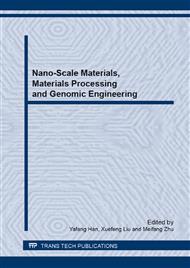[1]
Zhaoqian Li, Hejun Li,Wei Li, Jie Wang, Shouyang Zhang, Juan Guo, Preparation and ablation properties of ZrC–SiC coating for carbon/carbon composites by solid phase infiltration. Applied Surface Science, 258 (2011) 565–571.
DOI: 10.1016/j.apsusc.2011.08.102
Google Scholar
[2]
D.D. Jayaseelan, R.G.Sá,P.Brown, W.E. Lee, Reactive infiltration processing(RIP) of ultra-high temperature ceramics (UHTC) into porous C/C composite tubes, Journal of the European Ceramic Society, 31 (2011)361–368.
DOI: 10.1016/j.jeurceramsoc.2010.10.013
Google Scholar
[3]
Chen Zhao-ke, Xiong Xiang, Li Guo-dong, Wang Ya-lei, Ablation behaviors of carbon/carbon composites with C-SiC-TaC multi-interlayers. Applied Surface Science 255 (2009) 9217–9223.
DOI: 10.1016/j.apsusc.2009.07.006
Google Scholar
[4]
M.M. Opeka, I.G. Talmy, J.A. Zaykoski, Oxidation-based materials selection for 2000℃+ hypersonic aero-surfaces: Theoretical considerations and historical experience, J. Mater. Sci. 39 (2004) 5887.
DOI: 10.1023/b:jmsc.0000041686.21788.77
Google Scholar
[5]
Jacobson NS, Curry DM. Oxidation microstructure studies ofreinforced carbon/carbon. Carbon 2006, 44:1142–50.
DOI: 10.1016/j.carbon.2005.11.013
Google Scholar
[6]
Feng Tao, Li He-Jun, Fu Qian-Gang, Yang Xi, Wu Heng, High-temperature erosion resistance and aero-dynamic oxidation mechanism of multi-layer MoSi2–CrSi2–Si/SiC coated carbon/carbon composites in a wind tunnel at 1873 K, CARBON 50 (2012) 2171– 2178.
DOI: 10.1016/j.carbon.2012.01.027
Google Scholar
[7]
Mario Tului, Giuliano Marino, Teodoro Valente, Plasma spray deposition of ultrahigh temperature ceramics, Surface & Coatings Technology 201 (2006) 2103– 2108.
DOI: 10.1016/j.surfcoat.2006.04.053
Google Scholar
[8]
A. Sayir, Carbon fiber reinforced hafnium carbide composites, J. Mater. Sci. 39(2004) 5995.
Google Scholar
[9]
C. Friedrich, R. Gadow, M. Speicher, Protective multilayer coatings for carbon–carbon composites, Surface and Coatings Technology 151–152 (2002) 405–411.
DOI: 10.1016/s0257-8972(01)01655-3
Google Scholar
[10]
M Huang, K Z Li, H J Li, Q G Fu, G D Sun, A Cr–Al–Si oxidation resistant coating for carbon/carbon composites by slurry dipping, Carbon, 2007, 45:1124–6.
DOI: 10.1016/j.carbon.2007.01.010
Google Scholar
[11]
Wu H, Li HJ, Wang YJ, Fu QG, He ZB, Wei JF. Effect of deposition temperature on microstructures and properties of MoSi2 coating prepared by low pressure chemical vapor deposition, J Inorg Mater 2009, 24:392–6.
DOI: 10.3724/sp.j.1077.2009.00392
Google Scholar
[12]
Zhang YL, Li HJ, Fu QG, Yao XY, Li KZ, Jiao GS. An oxidation protective Si–Mo–Cr coating for C/SiC coated carbon/carbon composites, Carbon 2008, 46:179–82.
DOI: 10.1016/j.carbon.2007.10.022
Google Scholar
[13]
Chen Zhaoke, Xiong Xiang, Li Guodong, Wang Yalei, Ablation behaviors of carbon/carbon composites with C-SiC-TaC multi-interlayers, Applied Surface Science 255(2009) 9217–9223.
DOI: 10.1016/j.apsusc.2009.07.006
Google Scholar


